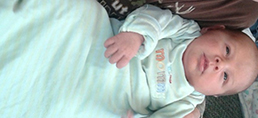
Skin-to-skin is something you might have heard about. Sometimes called kangaroo care, it’s been used for preemie babies. Now, it is encouraged for all births.
What is it? It’s putting your baby right to your chest for skin-to-skin contact. It is done right after birth.
Some parents wonder about the white, waxy substance on the baby and if it should be wiped off. This substance is vernix and may be rubbed in like a lotion. If you are concerned about it, the baby can be wiped off first.
After baby is placed on you, you will both be covered with a blanket. We highly encourage skin-to-skin for at least the first hour, but it should also continue after your new family goes home.
Skin-to-skin is also encouraged for fathers. If mom has a c-section, skin-to-skin is something great for dad to do because it can be difficult for mom if she’s on the surgical table (although it is possible).
What are the benefits of skin-to-skin contact? We know it helps:
- Regulate the new baby’s temperature
- Regulate the baby’s blood sugar
- Encourage bonding, which is important for mom and dad
- Stabilize baby’s heart rate and respiratory rate
- Mom breastfeed sooner
Babies can find the breast and self-attach when mom and baby are skin-to-skin. If you don’t plan to breastfeed, skin-to-skin is still important for bonding.
Studies have shown that babies cry less with skin-to-skin, as opposed to when they’re separated from their parents.
Skin-to-skin is promoted in all Baby-Friendly Hospitals.
A Swedish study in 2007 showed that after a c-section, the baby may sleep sooner and cry less if skin-to-skin contact is made with the dad. Although this study was small, it followed babies who were skin-to-skin with dad and babies who were instead placed in the bassinet. The babies who were held skin-to-skin calmed down more quickly.
We also know that when dads have skin-to-skin time with baby, it releases a hormone in them called oxytocin—just as in mom. The hormone, often called “the love hormone,” helps promote bonding.
Did you have skin-to-skin time with your baby? Did the new father?
If you’re expecting, make it a priority.
 /a>
/a>
 /a>
/a>
 /a>
/a>
This is an awesome post, I had my first baby 6 months ago and the best feeling after delivering was to share that skin to skin moment. She had trouble regulating her temperature during the first day or so, so my husband and I had back and forth skin-to-skin time with her and wouldn’t you know it she warmed right up! I knew that it was good but I didn’t really understand the science behind it. Thanks so much for sharing this informative piece at Welcome Home Wednesday! We really hope to have you back tomorrow, this was a great read & I learned something new!
Ohh great,skin to skin touch makes a good relation between kids and dad.It’s now scientifically proved.
I had skin to skin contact with my son back in the 80’s. Back then it was considered a holistic hippy thing that most people didn’t hold merit to. But, I still remember holding him close and breathing with him. I will never lose that feeling. I’m so glad that there is science proving how beneficial it is xo
I was lucky enough to have skin to skin for the first two hours with both my kids immediately after birth. Benefits of having a midwife!!!
Thanks for sharing at #bloggerspotlight